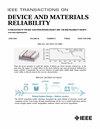由于NCF夹带导致的微凸点焊料脱湿和可靠性挑战
IF 2.3
3区 工程技术
Q2 ENGINEERING, ELECTRICAL & ELECTRONIC
IEEE Transactions on Device and Materials Reliability
Pub Date : 2025-03-19
DOI:10.1109/TDMR.2025.3571531
引用次数: 0
摘要
铜柱微凸点焊点的可靠性对于2.5D和3D集成等先进封装技术至关重要。随着非导电膜(NCF)热压键合技术的广泛应用,由NCF夹持引起的焊料脱湿已成为可靠性问题之一。在这项研究中,我们制造了具有控制NCF厚度和粘度的测试车,以有意地诱导焊料脱湿。这些测试车经过多次回流循环或高温储存(HTS)来检查脱湿行为的演变,并评估热预算对焊料润湿性的影响。通过微观结构分析和脱湿速率测量,我们发现金属间化合物(IMC)的生长在连续回流过程中的反复脱湿中起着关键作用。提出了一种模型方法来描述由于IMC的增长和NCF夹持的尺寸分布,脱湿速率如何随着回流循环次数的增加而降低。这些发现为了解与焊料脱湿相关的失效机制提供了见解,并为预测高级封装过程中多次回流循环后微凸点互连的可靠性提供了工具。本文章由计算机程序翻译,如有差异,请以英文原文为准。
Solder Dewetting and Reliability Challenges in Microbumps Due to NCF Entrapment
The reliability of solder joints in Cu pillar microbumps is critical for advanced packaging technologies such as 2.5D and 3D integration. As thermocompression (TC) bonding with non-conductive film (NCF) becomes widely adopted, solder dewetting caused by NCF entrapment has emerged as one of major reliability concerns. In this study, we fabricated test vehicles with controlled NCF thickness and viscosity to intentionally induce solder dewetting. These test vehicles underwent multiple reflow cycles or high-temperature storage (HTS) to examine the evolution of dewetting behavior and assess the impact of thermal budget on solder wettability. Through microstructural analysis and dewetting rate measurements, we found that intermetallic compound (IMC) growth played a key role in recurrent dewetting during successive reflows. A modeling approach was proposed to describe how the dewetting rate decreases with increasing reflow cycles due to IMC growth and the size distribution of NCF entrapment. These findings provide insight into failure mechanisms related to solder dewetting and a tool for predicting the reliability of microbump interconnects after multiple reflow cycles during advanced packaging.
求助全文
通过发布文献求助,成功后即可免费获取论文全文。
去求助
来源期刊

IEEE Transactions on Device and Materials Reliability
工程技术-工程:电子与电气
CiteScore
4.80
自引率
5.00%
发文量
71
审稿时长
6-12 weeks
期刊介绍:
The scope of the publication includes, but is not limited to Reliability of: Devices, Materials, Processes, Interfaces, Integrated Microsystems (including MEMS & Sensors), Transistors, Technology (CMOS, BiCMOS, etc.), Integrated Circuits (IC, SSI, MSI, LSI, ULSI, ELSI, etc.), Thin Film Transistor Applications. The measurement and understanding of the reliability of such entities at each phase, from the concept stage through research and development and into manufacturing scale-up, provides the overall database on the reliability of the devices, materials, processes, package and other necessities for the successful introduction of a product to market. This reliability database is the foundation for a quality product, which meets customer expectation. A product so developed has high reliability. High quality will be achieved because product weaknesses will have been found (root cause analysis) and designed out of the final product. This process of ever increasing reliability and quality will result in a superior product. In the end, reliability and quality are not one thing; but in a sense everything, which can be or has to be done to guarantee that the product successfully performs in the field under customer conditions. Our goal is to capture these advances. An additional objective is to focus cross fertilized communication in the state of the art of reliability of electronic materials and devices and provide fundamental understanding of basic phenomena that affect reliability. In addition, the publication is a forum for interdisciplinary studies on reliability. An overall goal is to provide leading edge/state of the art information, which is critically relevant to the creation of reliable products.
 求助内容:
求助内容: 应助结果提醒方式:
应助结果提醒方式:


